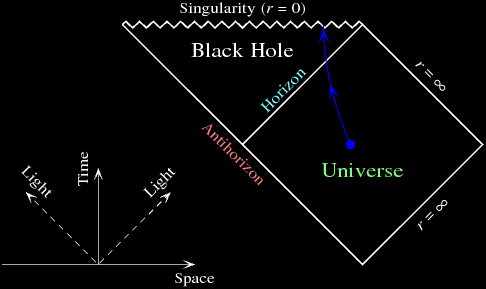What is a Black
Hole?
In
our universe, matter behaves according to four
fundamental forces of nature: Electromagnetism, the
Strong Nuclear Force, the Weak Nuclear Force, and
Gravity. When matter or energy occupies a region of
space, its interaction changes the local curvature of
space-time itself. When matter moves through space, it
accelerates according to the curvature of the space
which it occupies. All forms of energy bend space-time.
Since gravity is an extremely weak force, the weakest of
the fundamental forces, it takes a large amount of mass
to create a significant gravitational field.
A black hole is merely such a region of
space-time with a gravitational pull so great that its
escape velocity is greater than the speed of light. So,
no form of matter or energy can escape its boundary
under classical conditions. The boundary of a black hole
is called the event horizon. This is because information
about events which occur 'within' a black hole is hidden
to the outside.
The term
'black hole,' was coined by the renowned physicist
John Wheeler for its perfect absorbsion of light.
However the description of black holes as infinite,
single-directional wells is partly inaccurate.
Gravitational fields of General Relativity are not the
only physical differentials which apply to black holes.
Quantum Mechanics and Thermodynamics are also
necessarily involved in forming a more complete picture
of black holes which has been developing steadily for
many decades.
How are Black Holes
formed?
Black
holes typically form under the collapse of dying stars.
The end of a star's life is largely determined by its mass
and chemistry. Our sun will radiate its outerlayer as a
red giant and become a white dwarf. The sun will not
quickly run out of fuel. Stars of more than roughly 8
solar masses may burn through their nuclear fuel. When the
series of high-energy, high pressure nuclear fusion
reactions within a large star ends with the fusion of Iron
in the center of the star, low outward pressures cannot
overcome the gravitational pull of the star. This results
in a catastrophic collapse, followed by an astronomically
energetic supernova explosion. The collapsed cores of
stars less than 25 solar masses typically form neutron
stars with the density of atomic nuclei. Though there is
an upper limit in terms of mass, larger supernovae cores
collapse into black holes.
|

